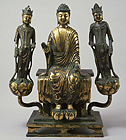Kanjo-ban (Banner for the Kanjo Ceremony)
1st floor Room 1
April 24, 2012 (Tue) -
March 31, 2013 (Sun)

The building was designed by Yoshio Taniguchi and has been furnished with the latest in conservation technology. The reference room on the 2nd floor mezzanine has the "digital archive" which allows visitors to view the entire collection of Horyuji Treasures on computer with explanations provided in Japanese, Chinese, Korean, English, and French. A restaurant is located on the ground floor.
* The Horyuji Treasures consist of over 300 valuable objects, mainly from the 7th - 8th century, which were donated to the Imperial Household by Horyuji Temple in 1878.

Kanjo-ban (Banner for the Kanjo Ceremony) (detail), Asuka period, 7th century (National Treasure)
1st floor Room 1
April 24, 2012 (Tue) - March 31, 2013 (Sun)
Exhibits:
Kanjo-ban (Banner for the Kanjo Ceremony), Asuka period, 7th century (National Treasure)
Two Small Ban (Ritual Banners), Asuka period, 7th century (Important Cultural Property)

Amida (Amitabha) and Two Attendants, Asuka period, 7th century (Important Cultural Property)
1st floor Room 2
April 24, 2012 (Tue) - March 31, 2013 (Sun)

Cabinet, Nara period, 8th century (National Treasure)
2nd floor Room 4
August 7, 2012 (Tue) - September 30, 2012 (Sun)
Including:
Cabinet, Nara period, 8th century (National Treasure)
Box, Design of flowers, butterflies, and birds in gold and silver paint, Nara period, 8th century (Important Cultural Property)
Needle Case, With bachiru, Nara period, 8th century (Important Cultural Property)

Incense Burner with Magpie's Tail-shaped, Asuka period, 7th century (National Treasure)
2nd floor Room 5
April 24, 2012 (Tue) - March 31, 2013 (Sun)
Exhibit includes:
Incense Burner with Magpie's Tail-shaped, Asuka period, 7th century (National Treasure)
Dragon-head Pitcher, Asuka period, 7th century (National Treasure)
Mirror with design of Sea and Islands, Tang dynasty or Nara period, 8th century (National Treasure)

Fudo Myoo (Acalanatha) with Two Boy Attendants(detail), Nanbokucho period, 14th century
2nd floor Room 6
September 4, 2012 (Tue) - September 30, 2012 (Sun)
Exhibit includes:
Painting:
Prince Shotoku and Five Attendants, Kamakura period, 13th -14th century
Fudo Myoo (Acalanatha) with Two Boy Attendants, Nanbokucho period, 14th century
Textiles:
Fragment of Ban (Buddhist Ritual Banner), Nara period, 7th - 8th century
Fragment of Ban (Buddhist Ritual Banner): "Banner Leg", With tortoiseshell pattern, Asuka - Nara period, 7th - 8th century